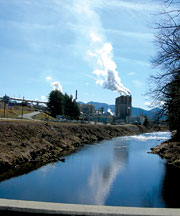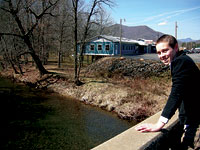Every day, the Blue Ridge Paper mill in Canton, one of Haywood County’s biggest employers, discharges more than 20 million gallons of treated industrial wastewater into the Pigeon River—which critics say is much too small a waterway to accommodate that much effluent.

No one disputes that water quality has improved substantially since environmentalists and downstream community activists waged a historic battle over the Pigeon River more than two decades ago. In the mid-1980s—long before a 1999 buyout transferred ownership from Champion International to the newly created, 44 percent-employee-owned Blue Ridge Paper Products—the water was commonly likened to black coffee, and the accompanying rotten-egg stench described as overpowering. A major cleanup effort implemented by Champion Paper in the mid-‘90s drastically improved the water’s appearance, and dioxin levels in fish plummeted.
A recent study by an independent expert on pulp-and-paper mills found Blue Ridge Paper’s wastewater to be among the least toxic discharges from such facilities worldwide. And in January, State Health Director Leah Devlin pronounced the Pigeon “both a public-health and environmental success story,” announcing that dioxin levels had dropped so much that North Carolina now considers fish from the river safe to eat.
On the heels of Devlin’s announcement, however, Clean Water for North Carolina, an Asheville-based nonprofit, had some news of its own: a report titled Blue Ridge Paper Products and the Myth of a Clean Pigeon River: Still Toxic After All These Years. Released in mid-February, the critique (compiled jointly with the Tennessee-based grass-roots group Clean Water Expected in East Tennessee) maintains that the Pigeon River still faces “a host of toxic and physical problems,” and that despite a 1997 agreement requiring the mill to improve water quality ASAP, there’s been little progress in reducing toxic releases since the buyout.
“I’m not aware that there’s any other paper mill this large on a river this small,” says Hope Taylor-Guevara, Clean Water’s executive director. “To have a mill this size on a mountain river is what this fight is about.”
And with the mill’s permit up for renewal and a public hearing likely in the coming months, both sides appear to be jockeying for position.
A colorful debate
The nonprofit acknowledges that dioxin levels have dropped, but Gracia O’Neill, who co-authored the report, fears the state’s announcement whitewashes the river’s continuing environmental problems. “Last time, just before the [permit] renewal was due, they raised one of the other fish-consumption advisory bans,” she notes, adding that she finds the timing of this latest announcement “a little interesting.”

Issued in 2001, the mill’s permit expired last November. But the company submitted its renewal request on time and the state Division of Water Quality granted a permit extension, because a team of U.S. Environmental Protection Agency experts who were involved in the permitting process had fallen behind schedule.
Meanwhile, the mill remains in compliance. But Taylor-Guevara, who was a biomedical researcher at the National Institutes of Health and Duke University before joining Clean Water for North Carolina, takes issue with the permit itself, which she says ignores a number of opportunities for achieving cleaner water in the Pigeon River. “They are in compliance,” she asserts, “but they’re in compliance with what we view as a very weak permit.” Technology identified by both an independent expert and the EPA, she maintains, could significantly improve water quality while saving the company money.
Wastewater-discharge permits are issued every five years, and public hearings for the Canton mill’s permit renewal have historically drawn large crowds and sparked fiery debate. Environmentalists formally challenged the 1996 permit, which actually allowed the mill to increase the amount of pollution it was producing. As a result, the EPA entered the fray and negotiated a 1997 settlement requiring the mill to implement “best management practices” and work for improved water quality “at the quickest possible pace.”
But that hasn’t happened, critics say. According to the Clean Water report, toxic releases in the river have been reduced by 4 percent since 1999, and color discharge by 7 percent—hardly the “quickest possible pace” of improvement, O’Neill maintains. “The idea behind these permits is to improve water quality over time,” she notes. “If they’re not getting more stringent … we’re not cleaning up our waterways.” The 2001 permit, the report notes, allows the mill to release 42,000 pounds of color per day—2,000 pounds more than the company was averaging two years before.
Central to the debate is the question of “color”—the difference between the clear water upstream from the mill and the tea-colored current below it. The complex issue has claimed center stage in past Pigeon River battles, and even its impact on the river’s health seems murky.
At various points in the bleaching process, the wood fiber releases dark pigments. “It’s a natural compound that’s being released, and it has very low toxic characteristics,” says state Environmental Engineer Sergei Chernikov, who will draft Blue Ridge Paper’s new permit. “The main issue of color is aesthetic.”
The Clean Water report disagrees, noting: “Color … has been dismissed by many regulators as only an ‘aesthetic’ problem. However, color is only the most visible component of a very complex mixture … [that contains] large quantities of toxic chemicals” at current discharge levels.
According to the federal toxic-releases inventory, the mill released some 110,000 pounds of toxic chemicals into the Pigeon in 2004, the most recent data available. Many of these compounds are known or suspected health hazards, including carcinogens, neurotoxicants and developmental toxicants.
Setting a standard
The big turnaround in Pigeon River water quality came in the mid-‘90s, when Champion Paper invested nearly $400 million in new technology in the wake of public outcry in connection with the 1996 permit. By the time Blue Ridge Paper bought the mill in 1999, the amount of color flowing into the river had been slashed by half. Dioxin levels also decreased significantly.
Since then, however, progress has slowed, and weak regulation is to blame, according to Clean Water for North Carolina.
Slower progress is to be expected, given the dramatic progress achieved in previous years, maintains Bob Williams, who oversees environmental and health regulations at the Canton mill. “We’re still making improvements, but they’re just not as great. We’ve done everything we were asked to do” by regulatory agencies, he notes.
Williams cites the findings of Norman Liebergott, an international expert on pulp-and-paper mills. Called in by environmentalists in 2001 to consider ways the mill could improve water quality, he was hired by Blue Ridge Paper last year to conduct a follow-up assessment. “Given the current state of adaptable technology and the mill’s already high level of environmental performance, future improvements are expected to be only marginally incremental,” Liebergott wrote in 2006.
Ironically, the Clean Water report invokes the same expert, noting that upgrades outlined by Liebergott in 2001 could have drastically improved water quality—but the company was not required to implement them.
A separate 2001 study conducted by an EPA technical team made similar recommendations, but both the paper mill and regulatory officials say the upgrades would have cost too much. The Clean Water report, however, cites an EPA financial analysis estimating that the $2 million upgrade would have saved the company $3.1 million annually in operating costs.
The color conundrum has a lengthy history: In 1985, the EPA took charge of permitting for the mill after determining that it wasn’t meeting federal Clean Water Act standards. The agency set a discharge limit of 50 “color units,” but after Champion International demonstrated that it couldn’t meet that standard, the EPA issued a variance that’s still in effect. Today, the Pigeon River meets the color standard miles downstream from the paper mill, after its discharge has been diluted. According to EPA official Marshall Hyatt, who’s familiar with the permit, in order to meet the 1985 standard at the point of discharge, the mill would have to reduce its average color releases to 19,000 pounds per day from the current average of 37,000 pounds per day.
Part of the problem, says Taylor-Guevara, is that North Carolina doesn’t have a numerical color standard—the law merely requires that “colored or other wastes” present in the discharge not interfere with public health, recreation, aquatic life, aesthetic quality or other uses. But without hard numbers, Taylor-Guevara maintains, the law has no teeth.
Chernikov, however, questions the need for a numerical standard. “Color perception depends on so many characteristics,” he notes. “The Blue Ridge Paper mill is one of very few mills that even has color requirements.”
Something fishy
A century ago, Hartford, Tenn.—a tiny town on the Pigeon River—earned the nickname “Widowville” because so many men had died from exposure to toxins, says raft guide Seth Smith, who grew up in the town and still lives there. And while that’s hardly the case today, Smith says the rotten-egg scent is still pretty common. “There’s definitely not been any major improvement” since the paper company changed hands in 1999, he asserts.
Smith, a volunteer with Clean Water Expected in East Tennessee, co-authored the Clean Water report. And even 26 miles downstream from the mill, where the outfitter is based, brownish foam occasionally seeps into his boat, he says. “The kids are a lot quicker to pick up on it than the adults. They ask their parents why there’s soap in the water.”
In the rafting community, it’s common to give rivers nicknames, notes Smith. “The Nolichucky is the Chuck,” he explains. “The Nantahala is the Nanny. But the Pigeon is called the Dirty Bird. That’s the only one where the name actually gets longer instead of shorter.”
Clean Water for North Carolina maintains that the mill’s discharge compromises the river’s value as a recreational resource. But Williams counters, “The rafting business is booming.”
The two sides take similarly disparate views of such issues as aquatic-habitat restoration, riverfront property values, overall public-health impacts and even the palatability of Pigeon River fish. “Despite the lifting of the fish-consumption advisory, we have been told that some fish caught below the mill within recent years have released a strong paper-mill odor when cooked, so it is likely that fish consumption in that downstream portion of the river will be minimal in the near future,” the report states.
It’s a classic divide, with the grass-roots groups characterizing regulations as lax and progress as lagging, while Blue Ridge Paper Products and the regulatory agencies emphasize that the Canton mill has one of the strictest permits in the country.
“There are a number of toxic compounds that have been released; nobody disputes that,” says Chernikov, the state environmental engineer. “That is industry. But what it comes down to is, would you rather have the mill or shut it down? You have to look at this in perspective, and you will see that this is one of the cleanest mills worldwide.”
As for the Clean Water report, Chernikov calls it “high on emotions.” Williams, meanwhile, points out that dealing with highly emotional debates is nothing new for the paper mill. “Anything we do is deemed suspect because of the trust issues over the years,” he says, adding, “Champion really poisoned the mix.” But Blue Ridge Paper continues to seek further water-quality improvements and has made many efforts to reach out to the community and partner with environmental organizations, he maintains, saying, “I think we are living up to our end of the bargain.”
Despite its high marks compared with other paper mills, however, O’Neill says much more needs to be done to protect the public health and restore the Pigeon River ecosystem.
“There’s a perception out there that the river’s clean now,” says O’Neill. “It’s not clean. It’s cleaner—but that’s not the same thing.”



Is the event at the Newport theater still on for this evening, January 22 at 7 pm?